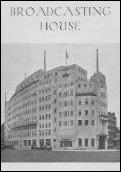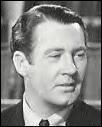
'Death
at Broadcasting House' and Val Gielgud
The film
was released in November 1934. Val Gielgud was appointed Head of Productions
in January 1929

'Death at Broadcasting
House' is something of a burlesque 'fun' whodunit in which someone
strangles Donald Wolfit live on the radio. It has a number of fascinating
glimpses into the interior design and system of broadcasting at BH
in the early 1930s, much of which were removed because the design
did not accord with the necessary functionalism of a broadcasting
and sound production centre.
A very good moving
sequence is included in the film with Val Gielgud managing a mix on
the revolutionary 'drama mixing panel'.

Some people could
describe the film as a 'musty British whodunit'. The distribution
in the US in 1941 was an attempt to cash in on the Hollywood-engendered
popularity of its star, Ian Hunter.
 Set
in a BBC radio studio, the story gets under way when a much despised
airwaves personality is murdered in the middle of a live broadcast.
Scotland Yard inspector Gregory (Ian Hunter) shows up to piece together
the clues and sift through the suspects. The solution to the mystery
hinges on the fact that the victim insisted upon broadcasting in a
private room, far removed from his fellow actors. Inspector Gregory
provides this solution by coming up with a transcription of the fatal
broadcast at a time when very few radio programmes were recorded for
archiving.
Set
in a BBC radio studio, the story gets under way when a much despised
airwaves personality is murdered in the middle of a live broadcast.
Scotland Yard inspector Gregory (Ian Hunter) shows up to piece together
the clues and sift through the suspects. The solution to the mystery
hinges on the fact that the victim insisted upon broadcasting in a
private room, far removed from his fellow actors. Inspector Gregory
provides this solution by coming up with a transcription of the fatal
broadcast at a time when very few radio programmes were recorded for
archiving.
'Death at Broadcasting
House' has far more historial and cultural significance than a quaint
mid afternoon nostalgia broadcast on BBC2 or Channel 4 television.
For its time, the production values in lighting, sound and plot were
rather high, but the characterisation and direction did not match
up to these intrinsic strengths.

It has been claimed
that elements of this film resurfaced in the 1942 Abbott & Costello
comedy ' Who Done it?'
The film's director
was Reginald Denham. The film does appear to attract an element of
sarcasm from contemporary academic and reviewers who make the understandable
and often repeated mistake of judging a cultural artefact by the standards
of the present time instead of the standards of the time of origin
and contemporary dissemination.
For example at
the following internet site: 'RADIO
ON THE SILVER SCREEN'
(This article was
published in issue 1 of Radio Days)
it is stated: 'Death
at Broadcasting House (1934) The powerful BBC myth is well illustrated
by this murder mystery set in the most publicised lump of pre-war
architecture. The overdone mystique of sound broadcasting is amply
demonstrated by the studio histrionics of the genuine Head of Drama,
Val (brother of John) Gielgud, who can only blame himself: he also
wrote the story. Guest star glimpses of Hannen Swaffer and the Gershom
Parkington Quintet.' These observations would appear to have been
made by 'Denis Gifford (sadly deceased in 2000), with assistance from
Alex Gleason, Grahame Newnham and Andy Emmerson.'
The film contains
a number of musical performances by: Eve Becke, Elizabeth Welch, Gillie
Potter, Hannen Swaffer, Percival Mackey's Band, and Ord Hamilton &
his band.

A
picture of the large vaudeville studio with a gallery published in
the 1933 BBC Yearbook

